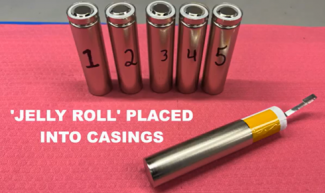An award-winning technology, developed by an American company with support from NETL, uses coal waste as an anode material in lithium-ion batteries — an innovation that researchers believe is an eco-friendly way to help the U.S. reduce reliance on foreign countries for critical materials that are needed to support the growing demand for batteries used in battery electric vehicles (BEVs), energy storage, and other products.
An anode is one of two electrodes within a lithium-ion battery, typically consisting of graphite deposited on copper foil, with graphite representing a significant component of a lithium-ion battery’s overall weight and cost. The graphite within lithium-ion battery anodes can be derived from natural graphite (mined as graphite) or synthetic graphite (derived from other hydrocarbons), with most of the graphite cost (on the order of $10,000/tonne) being due to processing temperature and time requirements.
In support of an environmentally sustainable and prosperous energy future, NETL awarded X-MAT®, a division of Semplastics, $1 million in 2020 for a three-year project to develop polymer-derived ceramic composite anodes that use coal as the carbon source for lithium-ion battery anodes. By heat treating coal and polymer derived ceramics as a substitute for graphite, it is possible to reduce both the processing time and temperature for anode materials, while also significantly increasing silicon loading.
According to Joe Stoffa, NETL technology manager for the Carbon Ore Processing Program, the X-MAT research team combined coal with its proprietary silicon forming resin-based technology to create carbon for lithium-ion batteries. This anode material was independently tested in in 18650 batteries, which are used in popular battery electric vehicles (BEVs). Results from the first 18650 cells that were made using coal and polymer-derived ceramic showed a retention capacity of 80% after 1,000 cycles of being fully charged and fully discharged, showcasing promising cycle life capabilities of the new technology.
Over the course of the project, the X-MAT team developed and tested the material in small, research-level coin cell batteries. The technology was then scaled up and independently tested in industrial format 18650 batteries, which are used in many applications, including BEVs, utility-scale energy storage, and consumer electronics. The scale-up and testing demonstrated that the material can be incorporated into batteries in large quantities and processed using standard, already available manufacturing equipment and processes.
X-MAT CEO Bill Easter told Waste Advantage Magazine, “The use of coal waste as a value-added material not only provides a domestic source for anodes but creates a new market for coal waste. We are grateful for the support of the Department of Energy and the NETL, who made this project possible. Our coal-based material can meet this demand in an eco-friendlier way and would lead to a domestic source for anode material, helping the U.S. reduce reliance on foreign countries for the critical materials needed to support the growing demand for electrification.”
Stoffa explained that adding coal waste to polymer-derived ceramics used in the batteries offers a range of benefits and is low-cost and scalable compared to alternative approaches. He said the technology has the potential to answer a growing demand for lithium-ion anode materials.
According to Benchmark Mineral Intelligence, “There are about 150lbs of graphite per electric vehicle and by 2035, it has been estimated that over 150 new graphite mines would be required to meet projected demand.” Graphite makes up about 28% of the typical EV battery. The total amount of graphite needed would reach many millions of tons by 2035, and the energy, time and resources required to mine or produce graphite at this scale is daunting.
“Based on the results of our research and development funded by the Department of Energy’s National Energy Technology Laboratory, we believe that coal waste can play a major role in mitigating this shortfall and it is already being produced in the volumes that would be required,.” according to X-MAT.
The X-MAT technology recently received the Voltage Award from the Battery Innovation Center. The award recognizes an emerging company and/or technology with the highest potential to make a difference in batteries and electrification.
Stoffa said NETL’s support of the technology development is consistent with the Lab’s mission of advancing new technologies that support energy innovation.
“At the end of the project, the X-MAT anode material has demonstrated stability in the 18650 form factor, and shows promise as a high silicon loaded carbon anode material with higher nominal voltage that could cost less than incumbents, while having a significant co-benefit through the utilization of coal waste,” Stoffa said.
NETL’s Carbon Ore Processing Program supports novel technologies for producing valuable products from carbon ore wastes. Laboratory and pilot-scale research and development supported by the program aims to elevate the value of U.S. carbon ore resources and transform its use for the future. The program focuses on developing a range of coal-derived products outside of traditional thermal and metallurgical markets, spanning the entire value spectrum from high volume through high value.
NETL is a DOE national laboratory that drives innovation and delivers technological solutions for an environmentally sustainable and prosperous energy future. With its world-class talent and research facilities, NETL is ensuring affordable, abundant and reliable energy that drives a robust economy and national security, while developing technologies to manage carbon across the full life cycle, enabling environmental sustainability for all Americans.




